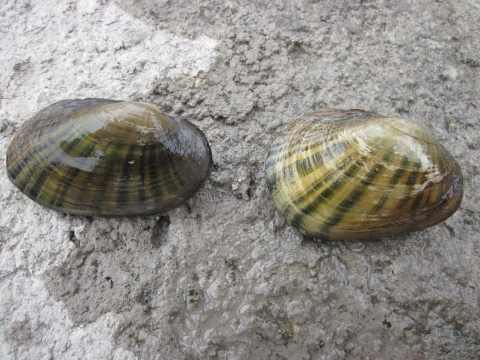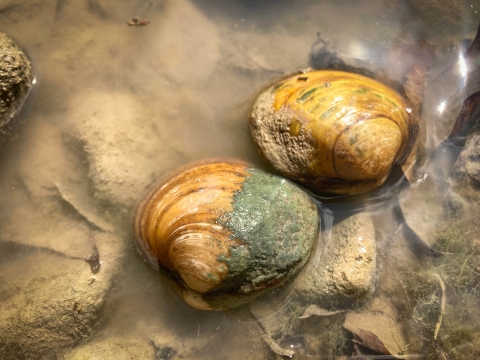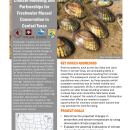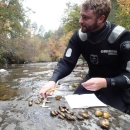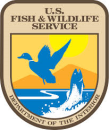Location













States
TexasEcosystem
River/streamIntroduction
Freshwater mussels are important filter feeders that remove algae, bacteria, nutrients, and pollutants from rivers and lakes. In Texas, there are 12 species of freshwater mussels, such as the Texas fatmucket (Lampsilis bracteata), currently listed or proposed for listing under the Endangered Species Act (ESA) (USFWS). Freshwater mussel issues are on the forefront of conservation, especially in the United States, because they are immobile, sensitive to ecosystem changes, and serve as indicators of habitat alterations or degradation.
In order to protect the endemic species of Central Texas from ecosystem stressors, River Authorities and land owners are entering into voluntary Candidate Conservation Agreements with Assurances (CCAA). These CCAAs exist between the U.S. Fish and Wildlife Service (USFWS) and other parties, such as the Brazos River Authority or Lower Colorado River Authority to provide guidance for the voluntary conservation and management of these species and the habitats on which they rely. Current CCAAs are working to protect Texas hornshell (Popenaias popeii), Texas fawnsfoot (Truncilla macrodon), and Balcones spike (Fusconaia iheringi) and their habitats by conducting research and reducing or eliminating threats where possible, such as pollution.
Climate change is another threat causing increased stress on riverine ecosystems through warming of stream temperatures and altering streamflows; however, current climate data is projected at global scales, making it difficult to determine the extent of changes that will impact riverine system functions in Central Texas. Changes in precipitation and air temperature directly impact climate-dependent indicators of stream health such as streamflow and water temperature. Texas is anticipated to experience an increase in mean annual temperatures and a decrease in average rainfall, furthering the degradation of instream mussel habitat.
Research conducted by Texas A&M, USFWS, and The Nature Conservancy is utilizing high resolution, downscaled climate projections to model the extent of climate impacts on streamflow and stream temperature in the San Saba and Llano Rivers. During this project, researchers calculated the degree to which changes in streamflow and temperature will impact the population of the Texas fatmucket. From this information, land managers and conservationists can determine the best steps for protecting the species in the future.
Key Issues Addressed
Listing a plant or animal as federally protected under the ESA provides the USFWS with mechanisms that can be used to prevent extinction of a species. However, this level of protection is the federal government’s last line of conservation defense and has implications for natural resources managers and water users. Coordinated and collaborative voluntary conservation and research efforts for at-risk freshwater mussels in central Texas are needed to support opportunities for conservation actions that may preclude the need for listing.
Tributaries within central Texas, such as the San Saba and Llano Rivers of the Colorado River, contain habitat for numerous species. Their significance also extends to contributing to the persistence and health of the Colorado River, which supplies drinking water and recreational opportunities to millions of people. Current regional climate projections suggest an increase in mean annual air temperatures and precipitation variability, both of which are expected to have effects on these tributaries. However, downscaled projections are needed to understand the exact degree of impact that changes in temperature and precipitation will have on Texas fatmucket populations in these streams.
Individual freshwater mussel species have varying preferences for water quality conditions, such as streamflow and stream temperature. Despite varying ecological niches, the vast majority of mussels demonstrate sensitivity to ecosystem changes due to their limited mobility. Changes in temperature and precipitation can cause changes to instream habitats that are required for freshwater mussel function and persistence. These shifts can lead to reduced windows for the female brooding season and an increase in the number of days where streamflow falls below the level required to maintain tolerable water quality. Prior to the Texas fatmucket project, there were limited high resolution projections to understand the extent of riverine ecosystem changes in central Texas due to climate change climate change
Climate change includes both global warming driven by human-induced emissions of greenhouse gases and the resulting large-scale shifts in weather patterns. Though there have been previous periods of climatic change, since the mid-20th century humans have had an unprecedented impact on Earth's climate system and caused change on a global scale.
Learn more about climate change , as well as subsequent impacts on mussel population.
Project Goals
- Determine the projected changes in streamflow and stream temperature for both the San Saba and Llano River by using high resolution, downscaled climate projections.
- Evaluate the potential climate change impacts on the Texas fatmucket.
- Create CCAAs that identify voluntary conservation actions for at-risk freshwater mussel species and their habitats.
Project Highlights
- Conservation Agreements in Action: There are several CCAAs that focus on the conservation of freshwater mussel species in central and east Texas. These CCAAs encourage non-federal partners to engage in voluntary conservation actions such as habitat restoration, research, monitoring, education, and outreach that address threats for covered mussel species. By implementing proactive conservation measures, partners receive assurances that no additional conservation measures will be imposed if the species is listed under the ESA.
- Projected Impacts of Climate Change: Researchers are applying high resolution, downscaled climate change projections to temperature and streamflow data from six USGS streamflow gauges and three Texas A&M-managed temperature stations. By using statistical analysis, they calculated that central Texas will likely experience an increase of air temperature between 1°C to 4°C, causing the Texas fatmucket's mortality rate to exceed 5% on an additional 100 days each year. Meanwhile, there is an anticipated 50 to 100mm reduction in annual precipitation averages across both rivers, causing up to an 80 day increase where minimum flow is below species requirement for survival.
- Climate Modeling at Management-Appropriate Scales: Since most climate data is collected and analyzed on a global scale, project researchers needed to downscale the climate projections to provide managers with region-specific insights. Researchers used statistical methods to refine global-scale projections into a scale local to the San Saba and Llano Rivers. Analysis of the finer-scale data revealed the Texas fatmucket is expected to experience temperatures above their lethality threshold and streamflow rates lower than necessary for tolerable water quality and quantity. This insight can inform future conservation efforts, such as flow balancing and flood releases to supplement streamflow to subsistence levels.
Lessons Learned
Propagation Success: The major recovery plans for mussel conservation include propagation and release of the species. Researchers successfully reproduced the Texas fatmucket in hatcheries as well as determined suitable areas for reintroduction
Effective communication and partnerships are vital for large-scale conservation efforts. There are various stakeholders engaged in freshwater mussel conservation in central Texas including researchers who conduct climate science, landowners who engage in voluntary conservation, and biologists who provide regional coordination.
CCAAs are a form of voluntary agreements that provide incentives for non-federal entities, such as private landowners, Tribes, and state agencies to conserve at-risk species. The goal of these agreements and their voluntary conservation measures are to facilitate species recuperation. In some instances, conservation activities included within these agreements can include the augmentation of existing mussel populations. These efforts could become critical to future species conservation as known populations continue to decline and are at risk of extirpation. Through these voluntary agreements, non-federal entities are provided regulatory assurances that their proposed conservation efforts and other covered operational activities are protected against additional regulatory obligations in the event of a species being listed.
Additionally, on-going Texas fatmucket research demonstrates how researchers and the USFWS can collaborate to pursue conservation goals outside of formal agreements. In this example, climate scientists lacked knowledge of the biology and ecology of mussels, meanwhile the mussel conservationists had less expertise in collecting and calculating rain indices. As a result of this project’s collaboration, wildlife management agencies will be able to utilize climate projections at a finer scale to determine how mussel species are, and will continue to be impacted by climate change throughout central Texas. Although researchers focused on a single species for the impact analysis, the results were fine-tuned to be applicable to freshwater mussel species throughout the central Texas region. Similar analysis can be completed for other regional freshwater mussels, contributing to greater freshwater mussel conservation.
Next Steps
- Utilize the data collected and projections to inform a new CCAA to support increased collaboration among water users and managers to conserve freshwater mussel species native to Texas.
- Complete other research currently under-way for conservation of at-risk freshwater mussels and stream research.
- Continue to use climate projections at a finer scale to analyze the impacts of climate change on mussel populations.
Funding Partners
Resources
- U.S. Fish and Wildlife Service, Lower Colorado River Authority (LCRA), and LCRA Transmission Services Corporation. September 2023. Candidate Conservation Agreement with Assurances for the Texas Pimpleback (Cyclonaias petrina), Texas Fawnsfoot (Truncilla macrodon), Texas Fatmucket (Lampsilis bracteata) and Balcones Spike (Fusconaia iheringi) in the Lower Colorado River Basin below O.H. Ivie Reservoir.
- Brazos River Authority. 2021. Candidate Conservation Agreement with Assurances for the Balcones Spike and Texas Fawnsfoot in the Brazos River Basin. Waco, Tx. 176 pages.
- Wootel et al. (2023). “Projected Changes to Streamflow and Stream Temperature in Central Texas: How Much Will the River Flow?”
Contacts
- Adrienne Wootsen, South Central Climate Adaptation Science Center: amwootte@ou.edu
- Matt Johnson, U.S. Fish and Wildlife Service: matthew_s_johnson@fws.gov
CART Lead Author
Haylee Kraker, CART Intern
Suggested Citation
Kraker, H.,J. and Jewell, K., D. (2024). “Climate Modeling and Partnerships for Freshwater Mussel Conservation in Central Texas.” CART. Retrieved from https://www.fws.gov/project/climate-modeling-freshwater-mussel-conservation

